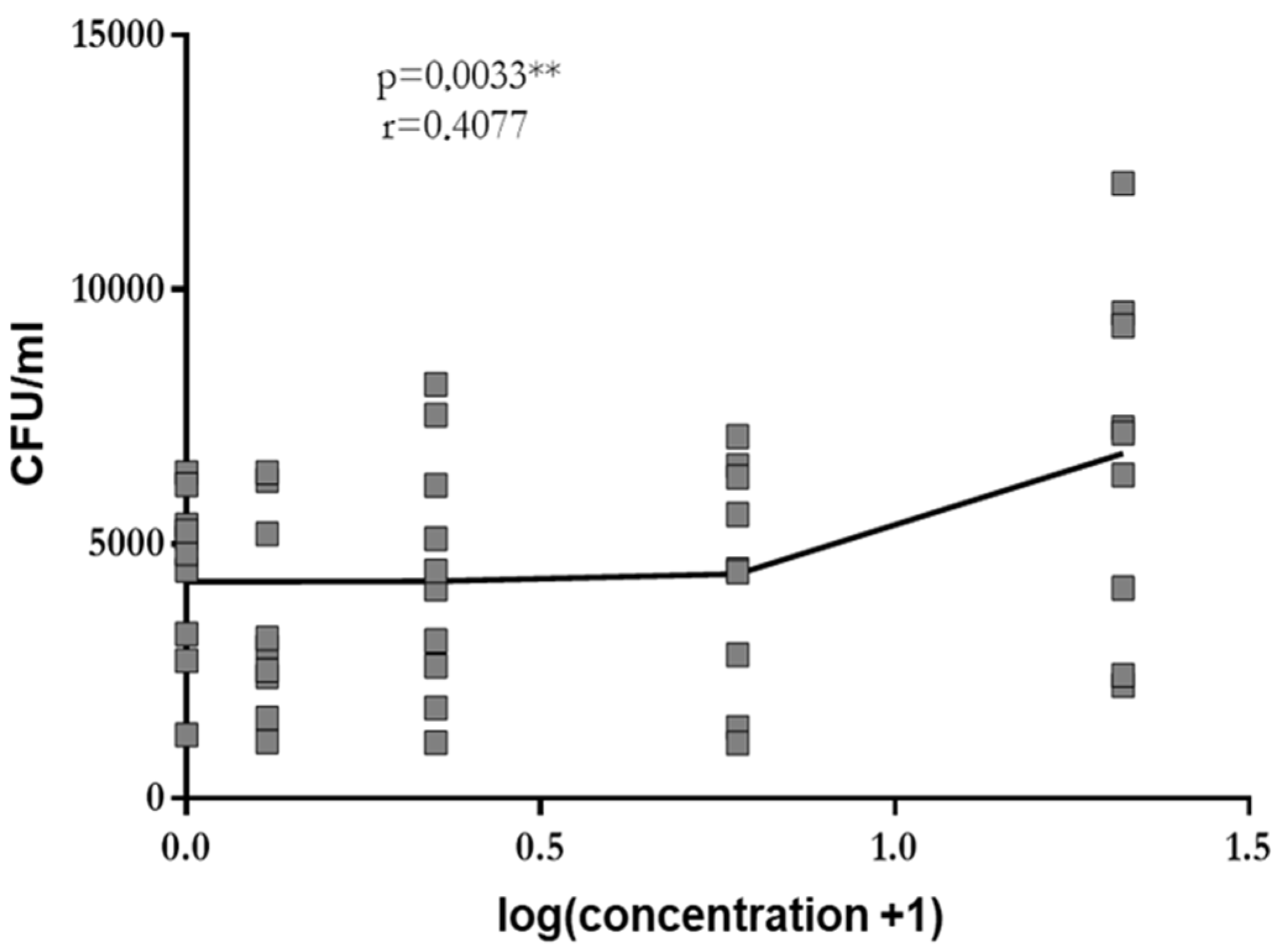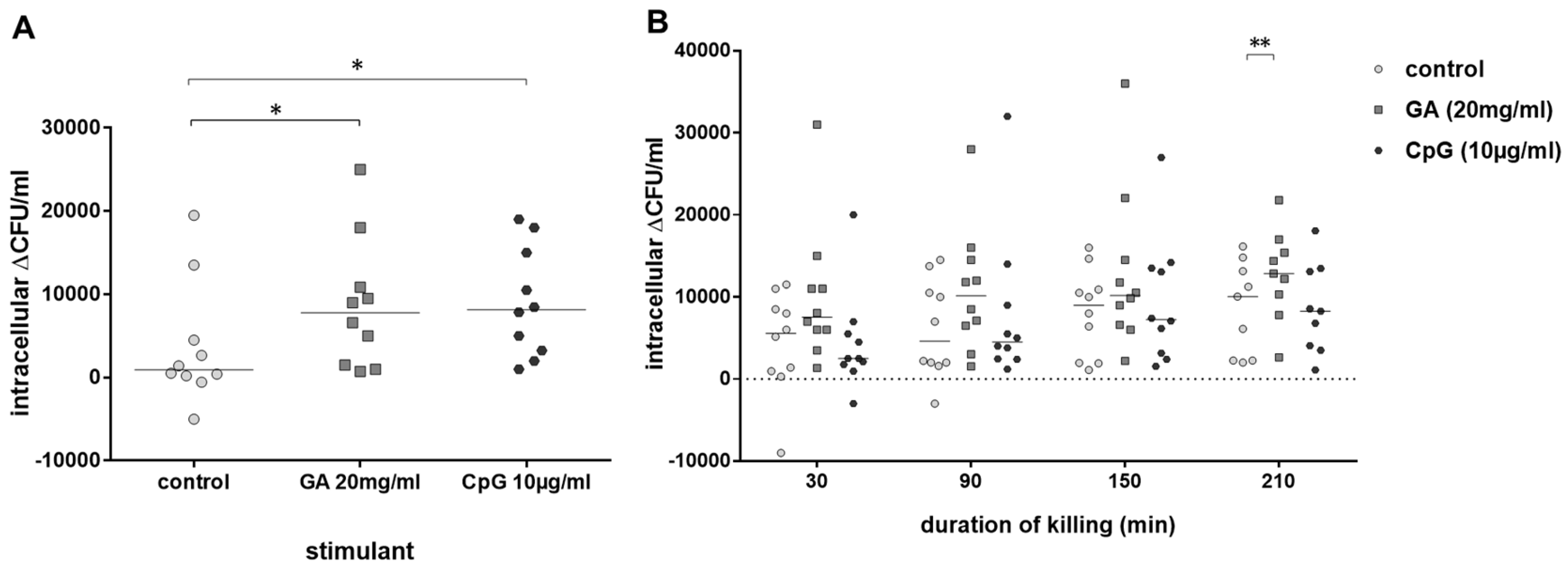Gum Arabic Increases Phagocytosis of Escherichia coli by Blood Leukocytes of Young and Old Healthy Volunteers
Abstract
1. Introduction
2. Results
3. Discussion
4. Materials and Methods
4.1. Materials
4.2. Volunteers
4.3. Ex Vivo Phagocytosis
4.4. Cytokines
4.5. Cell Viability
4.6. Statistics
5. Conclusions
Author Contributions
Funding
Institutional Review Board Statement
Informed Consent Statement
Data Availability Statement
Acknowledgments
Conflicts of Interest
Abbreviations
| BCG | Bacille Calmette–Guérin |
| CAPT | carbapenems, aminoglycosides, polymyxins and tigecycline |
| CpG | unmethylated cytosine-guanosin |
| CFU | colony-forming units |
| ELISA | enzyme-linked immunosorbent assay |
| E. | Escherichia |
| GA | Gum arabic |
| LPS | lipopolysaccharide |
| MAPTRI | Medicinal & Aromatic Plants & Traditional Medicine Research Institute |
| RIZ | Research Center for Emerging Infections and Zoonoses |
| RPMI | Roswell Park Memorial Institute |
| TLR | Toll-like receptor |
| XDR | extensively drug-resistant |
References
- The Review on Antimicrobial Resistance. Tackling Drug-Resistant Infections Globally: Final Report and Recommendations. The Review on Antimicrobial Resistance, Chaired by Jim O’Neill. Report Commissioned by the UK Prime Minister. 2016. Available online: https://amr-review.org/sites/default/files/160525_Final%20paper_with%20cover.pdf (accessed on 3 May 2021).
- Ioannou, P.; Plexousaki, M.; Dimogerontas, K.; Aftzi, V.; Drougkaki, M.; Konidaki, M.; Paschalidis, K.; Maraki, S.; Kofteridis, D.P. Characteristics of urinary tract infections in older patients in a tertiary hospital in Greece. Geriatr Gerontol Int. 2020, 20, 1228–1233. [Google Scholar] [CrossRef] [PubMed]
- Karakonstantis, S.; Gikas, A.; Astrinaki, E.; Kritsotakis, E.I. Excess mortality due to pandrug-resistant Acinetobacter baumannii infections in hospitalized patients. J. Hosp. Infect. 2020, 106, 447–453. [Google Scholar] [CrossRef] [PubMed]
- Lopez-Torrez, L.; Nigen, M.; Williams, P.; Doco, T.; Sanchez, C. Acacia senegal vs. Acacia seyal gums—Part 1: Composition and structure of hyperbranched plant exudates. Food Hydrocoll. 2015, 51, 41–53. [Google Scholar]
- Mortensen, A.; Aguilar, F.; Crebelli, R.; EFSA Panel on Food Additives and Nutrient Sources added to Food (ANS). Re-evaluation of acacia gum (E 414) as a food additive. EFSA J. 2017, 15, e04741. [Google Scholar] [CrossRef] [PubMed]
- Calame, W.; Weseler, A.R.; Viebke, C.; Flynn, C.; Siemensma, A.D. Gum arabic establishes prebiotic functionality in healthy human volunteers in a dose-dependent manner. Br. J. Nutr. 2008, 100, 1269–1275. [Google Scholar] [CrossRef] [PubMed]
- Baien, S.H.; Seele, J.; Henneck, T.; Freibrodt, C.; Szura, G.; Moubasher, H.; Nau, R.; Brogden, G.; Mörgelin, M.; Singh, M.; et al. Antimicrobial and Immunomodulatory Effect of Gum Arabic on Human and Bovine Granulocytes against Staphylococcus aureus and Escherichia coli. Front Immunol. 2020, 10, 3119. [Google Scholar] [CrossRef] [PubMed]
- Moskalev, A.; Stambler, I.; Caruso, C. Innate and Adaptive Immunity in Aging and Longevity: The Foundation of Resilience. Aging Dis. 2020, 11, 1363. [Google Scholar] [CrossRef]
- Angus, D.C.; Linde-Zwirble, W.T.; Lidicker, J.; Clermont, G.; Carcillo, J.; Pinsky, M.R. Epidemiology of severe sepsis in the United States: Analysis of incidence, outcome, and associated costs of care. Crit. Care Med. 2001, 29, 1303–1310. [Google Scholar] [CrossRef] [PubMed]
- Ewig, S.; Birkner, N.; Strauss, R.; Schaefer, E.; Pauletzki, J.; Bischoff, H.; Schraeder, P.; Welte, T.; Hoeffken, G. New perspectives on community-acquired pneumonia in 388,406 patients. Results from a nationwide mandatory performance measurement programme in healthcare quality. Thorax 2009, 64, 1062–1069. [Google Scholar] [CrossRef]
- Bauer, M.; Heeg, K.; Wagner, H.; Lipford, G.B. DNA activates human immune cells through a CpG sequence-dependent manner. Immunology 1999, 97, 699–705. [Google Scholar] [CrossRef]
- Bulut, O.; Kilic, G.; Dominguez-Andres, J.; Netea, M.G. Overcoming immune dysfunction in the elderly: Trained immunity as a novel approach. Int Immunol. 2020, 32, 741–753. [Google Scholar] [CrossRef]
- Fulop, T.; Larbi, A.; Douziech, N.; Fortin, C.; Guérard, K.; Lesur, O.; Khalil, A.; Dupuis, G. Signal transduction and functional changes in neutrophils with aging. Aging Cell 2004, 3, 217–226. [Google Scholar] [CrossRef] [PubMed]
- Schütze, S.; Ribes, S.; Kaufmann, A.; Manig, A.; Scheffel, J.; Redlich, S.; Bunkowski, S.; Hanisch, U.K.; Brück, W.; Nau, R. Higher mortality and impaired elimination of bacteria in aged mice after intracerebral infection with E. coli are associated with an age-related decline of microglia and macrophage functions. Oncotarget. 2014, 5, 12573–12592. [Google Scholar] [CrossRef]
- Metcalf, T.U.; Wilkinson, P.A.; Cameron, M.J.; Ghneim, K.; Chiang, C.; Wertheimer, A.M.; Hiscott, J.B.; Nikolich-Zugich, J.; Haddad, E.K. Human monocyte subsets are transcriptionally and functionally altered in aging in response to pattern recognition receptor agonists. J Immunol. 2017, 199, 1405–1417. [Google Scholar] [CrossRef]
- Sauce, D.; Dong, Y.; Campillo-Gimenez, L.; Casulli, S.; Bayard, C.; Autran, B.; Boddaert, J.; Appay, V.; Elbim, C. Reduced Oxidative Burst by Primed Neutrophils in the Elderly Individuals Is Associated With Increased Levels of the CD16bright/CD62Ldim Immunosuppressive Subset. J. Gerontol. Ser. A 2017, 72, 163–172. [Google Scholar] [CrossRef] [PubMed]
- Giamarellos-Bourboulis, E.J.; Tsilika, M.; Moorlag, S.; Antonakos, N.; Kotsaki, A.; Dominguez-Andres, J.; Kyriazopoulou, E.; Gkavogianni, T.; Adami, M.-E.; Damoraki, G.; et al. Activate: Randomized Clinical Trial of BCG Vaccination against Infection in the Elderly. Cell 2020, 183, 315–323. [Google Scholar] [CrossRef]
- Cabas, P.; Rizzo, M.; Giuffrè, M.; Antonello, R.M.; Trombetta, C.; Luzzati, R.; Liguori, G.; Di Bella, S. BCG infection (BCGitis) following intravesical instillation for bladder cancer and time interval between treatment and presentation: A systematic review. Urol. Oncol. Semin. Orig. Investig. 2021, 39, 85–92. [Google Scholar] [CrossRef]
- Corriden, R.; Hollands, A.; Olson, J.; Derieux, J.; Lopez, J.; Chang, J.T.; Gonzalez, D.J.; Nizet, V. Tamoxifen Augments the Innate Immune Function of Neutrophils Through Modulation of Intracellular Ceramide. Nat Commun. 2015, 6, 8369. [Google Scholar] [CrossRef]
- Kamal, D.; Hassanein, H.; Akah, M.; Abdelkawy, M.A.; Hamza, H. Caries Preventive and Antibacterial Effects of Two Natural Mouthwashes vs. Chlorhexidine in High Caries-risk Patients: A Randomized Clinical Trial. J. Contemp. Dent. Pract. 2021, 21, 1316–1324. [Google Scholar] [CrossRef]
- Ballal, A.; Bobbala, D.; Qadri, S.M.; Föller, M.; Kempe, D.; Nasir, O.; Saeed, A.; Lang, F. Anti-malarial effect of gum arabic. Malar. J. 2011, 10, 139. [Google Scholar] [CrossRef]
- Singh, B.; Sharma, S.; Dhiman, A. Acacia gum polysaccharide based hydrogel wound dressings: Synthesis, characterization, drug delivery and biomedical properties. Carbohydr. Polym. 2017, 165, 294–303. [Google Scholar] [CrossRef] [PubMed]
- Ngece, K.; Aderibigbe, B.; Ndinteh, D.; Fonkui, Y.; Kumar, P. Alginate-gum acacia based sponges as potential wound dressings for exuding and bleeding wounds. Int. J. Biol. Macromol. 2021, 172, 350–359. [Google Scholar] [CrossRef] [PubMed]




Disclaimer/Publisher’s Note: The statements, opinions and data contained in all publications are solely those of the individual author(s) and contributor(s) and not of MDPI and/or the editor(s). MDPI and/or the editor(s) disclaim responsibility for any injury to people or property resulting from any ideas, methods, instructions or products referred to in the content. |
© 2024 by the authors. Licensee MDPI, Basel, Switzerland. This article is an open access article distributed under the terms and conditions of the Creative Commons Attribution (CC BY) license (https://creativecommons.org/licenses/by/4.0/).
Share and Cite
Freibrodt, C.; Baien, S.; von Köckritz-Blickwede, M.; de Buhr, N.; Nau, R.; Seele, J. Gum Arabic Increases Phagocytosis of Escherichia coli by Blood Leukocytes of Young and Old Healthy Volunteers. Antibiotics 2024, 13, 482. https://doi.org/10.3390/antibiotics13060482
Freibrodt C, Baien S, von Köckritz-Blickwede M, de Buhr N, Nau R, Seele J. Gum Arabic Increases Phagocytosis of Escherichia coli by Blood Leukocytes of Young and Old Healthy Volunteers. Antibiotics. 2024; 13(6):482. https://doi.org/10.3390/antibiotics13060482
Chicago/Turabian StyleFreibrodt, Christin, Shima Baien, Maren von Köckritz-Blickwede, Nicole de Buhr, Roland Nau, and Jana Seele. 2024. "Gum Arabic Increases Phagocytosis of Escherichia coli by Blood Leukocytes of Young and Old Healthy Volunteers" Antibiotics 13, no. 6: 482. https://doi.org/10.3390/antibiotics13060482
APA StyleFreibrodt, C., Baien, S., von Köckritz-Blickwede, M., de Buhr, N., Nau, R., & Seele, J. (2024). Gum Arabic Increases Phagocytosis of Escherichia coli by Blood Leukocytes of Young and Old Healthy Volunteers. Antibiotics, 13(6), 482. https://doi.org/10.3390/antibiotics13060482






